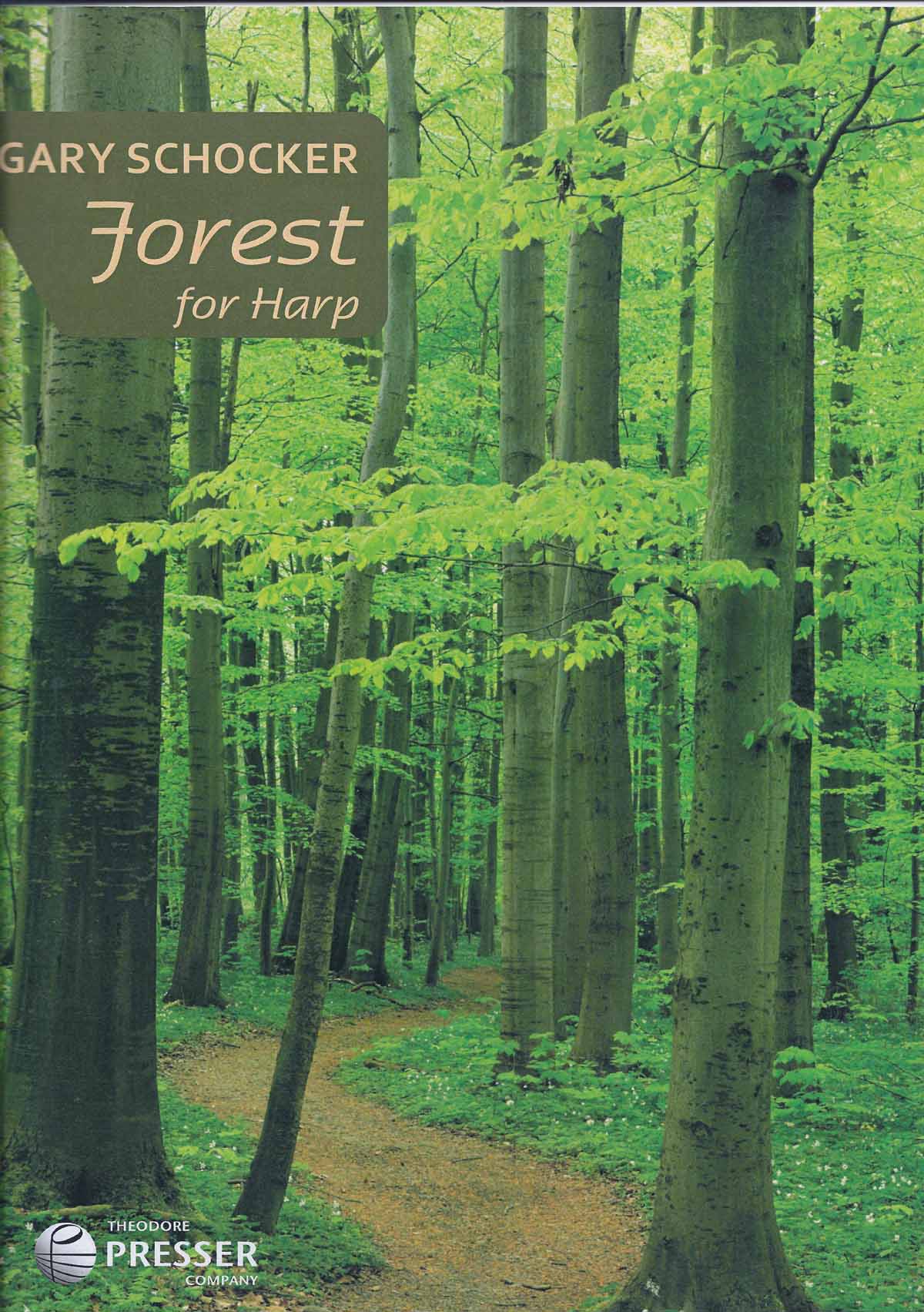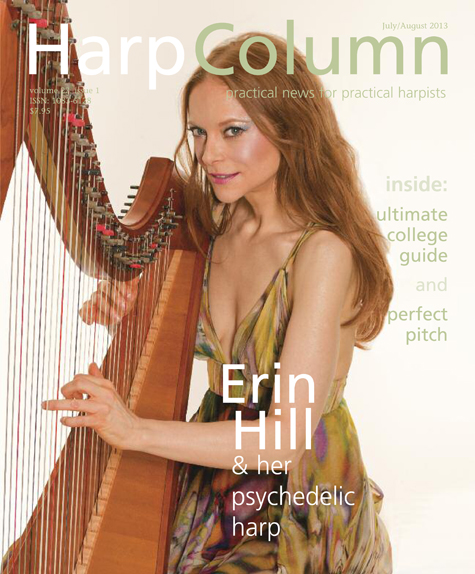
From Great Britain, eminent harpist Skaila Kanga sends us her Minstrel’s Gallery and Minstrel’s Holiday for consideration. Expertly constructed to align with the Associated Board of the Royal Schools of Music (ABRSM) graded exam syllabus for harp*, teachers will find a wealth of interesting material for the beginning harpist in these two collections.
The compositional style is inventive, at times beautiful, and these pieces are sure to engage students with their judicious sprinkling of effects (glissandi, timpanic sounds, enharmonic doublings, stage directions, etc.), colorful moods, and fanciful titles. Teachers who find the lack of fingerings in Minstrel’s Gallery a deterrent may be wooed back by the variety of keys and meters, along with the gradually increased rhythmic and technical complexity.
Minstrel’s Gallery offers 15 ABRSM grade one pieces and 15 pieces for grades 2 and 3—all of which can be played on the pedal or lever harp. E-flat tuning is assumed for lever harps but only 10 of the pieces actually require flats. No lever changes are needed while playing. The grade one selections start off simply with “Serenade” and “March of the Wooden Soldiers” employing the first and second fingers in both hands (with the occasional three-finger pattern). The collection progresses to numbers like “The Enchanted Palace” and “Garden of Dreams,” which use three-finger triadic figures in both hands and the odd octave.
The story continues with Minstrel’s Holiday, 20 pieces for ABRSM grades 3 and 4 on lever or pedal, almost all of which require an E-flat tuning—especially the ones with aeolian glissandi that little cherubs are certain to want to play. From time to time performers are required to move a few levers during a piece, and some fingerings and placing signs are indicated. Pieces in this collection increase in difficulty as one would expect—they are a little longer, use four-finger patterns, two-hand rolled chords, etc.
The only fly in the ointment, at least for the U.S. market, may be the price tags for these two collections. Hovering around $35 each, Minstrel’s Galleryand Minstrel’s Holiday could prove to be too hefty an investment to make on easy material that may only be used once. “Best of” sets from each collection priced around $10 would fare much better here.
Also, it bears mentioning that there are some parents who will feel that pieces with titles that include words such as wizard, magic, goblins, etc. are not appropriate for their children. Harry Potter fans, on the other hand, fly—don’t walk—to get your copy of Minstrel’s Gallery.
When an established, successful composer is moved to write for the harp and then makes the added leap of learning to play the instrument, there should be a reasonable amount of rejoicing in the harp community. Gary Schocker, the popular flute composer, is just such a personage. Three of his compositions are currently on the American Harp Society’s 20th National Competition list and five others from publisher Theodore Presser have been submitted for our consideration.
Mr. Schocker composes for the pedal harp, and these pieces we look at here are suitable for the intermediate player—although the jumps, reaches, and added voices that crop up in a few spots seem to call for a harpist with advanced ability. While all pedal changes are indicated (with the occasional missing or errant entry), there are few fingerings and a fair number of implied muffles—necessary to avoid unintended pedal slides. All in all, not a huge editing job for what we expect in “modern” music.
Primarily, Mr. Schocker seems interested in using the harp to create a particular mood or feeling, which he does effectively. The voicing is sparse—at times, just two voices with the occasional widely spaced chord. The harmonies are mostly tonal with dissonances that support the character of the particular piece, and the rhythms aren’t difficult. If players have a challenge with the writing, it may well be the amount of unvaried repetition in some of the works, which tend to make them harder to “sell” to an audience.
The title Sonata No. 1 sounds promising. Sonata No. 2 might be right around the corner. The first movement, “Changes,” starts in A minor with a slow, brooding conversation between soprano and bass that ultimately modulates to G-sharp minor. The first 36 bars are repeated, followed by a short coda. The second movement, “Procession, Remembering,” picks up cleverly, in the enharmonic equivalent, A-flat minor for a far away, questioning, minute or two. The final movement, “Face Forward,” is the most satisfying—an extended, cheerful, riff on a Bach motif in A-flat major.
Despite the whimsical sounding title, Treeludes is a collection of five somber and meditative pieces that each describes a different kind of tree. There are some lovely moments under the leafy canopies and the slow tempi conjure a sense of timelessness. “Waves” is a stand-alone mood painting in the same vein. The solemn pace evokes the emotional effect of water moving, rather than crashing at the beach.
Forest is a set of two arboreal visions. “Clearing” begins with a long introduction in a slow, lilting, 12/8. The rocking triplet accompaniment and major-minor chord shifts give the effect of branches swaying hypnotically, which, combined with the slow build and dynamic arc of the first 31 measures, provides the harpist an opportunity to do some nice music making. “Stream” is a modernized variant of the familiar La Source type of composition. The descending bubbling in this piece is considerably slower than its ancestors and chordal sections interspersed throughout make it less tiring for a student harpist.
Finally, Things I Learned From My Cat is a delightful collection of a dozen short pieces inspired by Mr. Schocker’s estimable feline, Mars Mandelbaum. These miniatures are concise and approachable with titles like “How to Frolic,” “Follow Your Nose,” and “Remember Kindness.” Adults as well as young people will enjoy their earnest lessons.
*
If you are unfamiliar with ABRSM exams you can visit [www.abrsm.org](http://www.abrsm.org/en/regions/usa/united-states/) for more information. •
John Wickey performs with the TrueNorth Harp Duo and the Modern Harp Quartet, and directs the newly formed Atlanta Harp Center (AHC) Harp Ensemble. He teaches, composes, and performs in the area and is on staff at the AHC.













